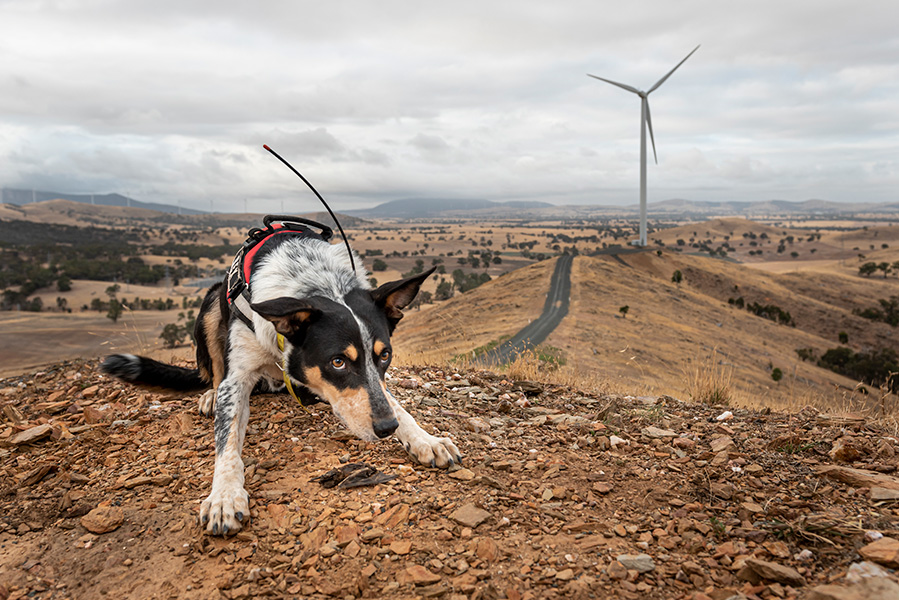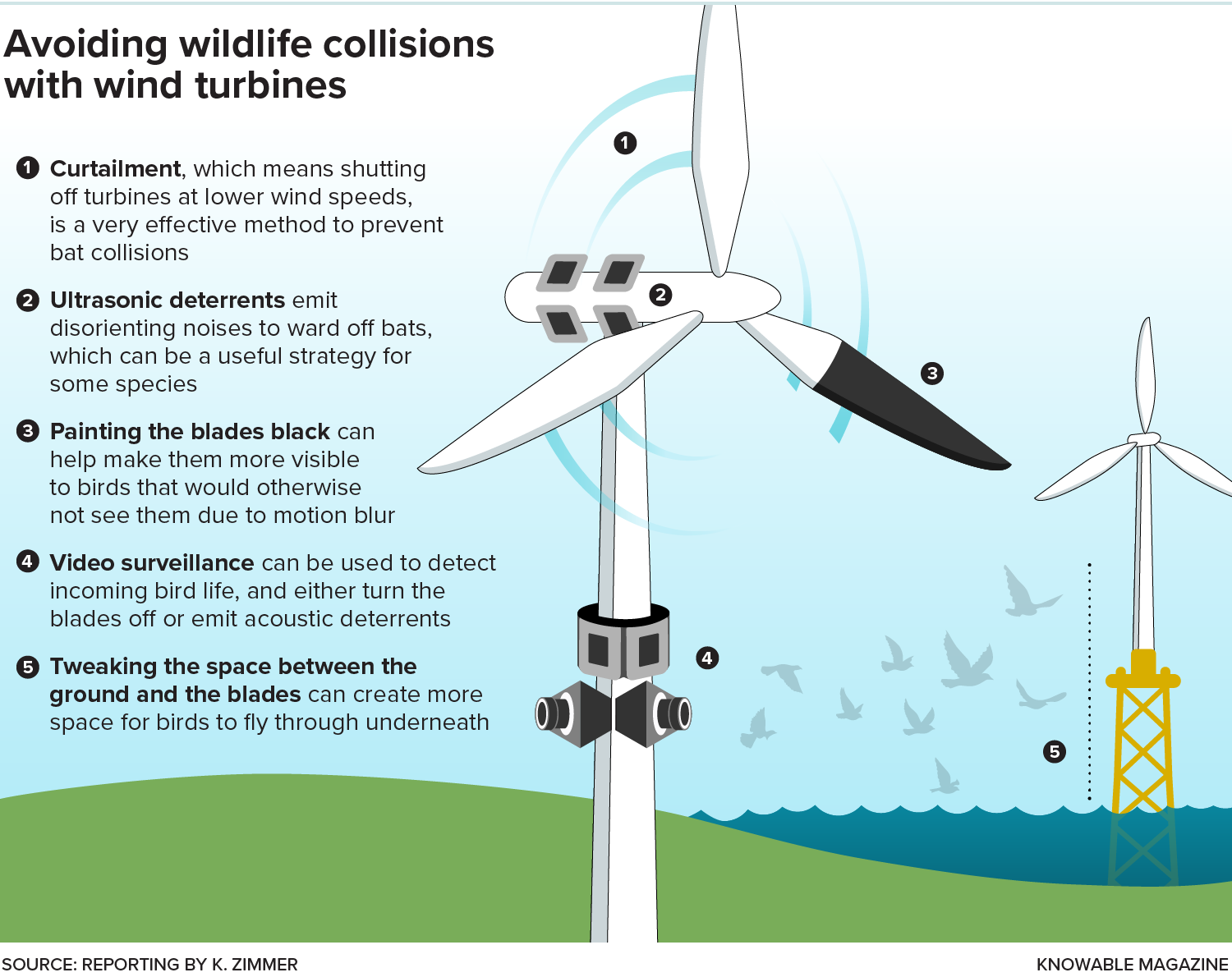How wind turbines could coexist peacefully with bats and birds
As wind power grows around the world, so does the threat the turbines pose to wildlife. From simple fixes to high-tech solutions, new approaches can help.
Support sound science and smart stories
Help us make scientific knowledge accessible to all
Donate today
About twice a month, many of Australia’s wind farms receive an important visit from dogs and their handlers. The dogs are professionals and know exactly what they’re there for. Eagerly, they run along transects under the wind turbines, sniffing until they catch a scent then lying down, sitting or freezing once they’ve located their targets: the carcasses of bats and birds that were killed by turbine collisions.
For nearly two decades, wind and wildlife ecologist Emma Bennett’s company, Elmoby Ecology, has been using canines to count the victims of wind turbines in southern Australia. The numbers are troubling. Each turbine yields four to six bird carcasses per year, part of an overall death toll from wind turbines that likely tops 10,000 annually for the whole of Australia (not including carcasses carried away by scavengers). Such deaths are in the hundreds of thousands for North America. Far worse are the numbers of dead bats: The dogs find between six and 20 of these per turbine annually, with tens of thousands believed to die each year in Australia. In North America, the number is close to a million.

In Australia, trained dogs are used to find and count the carcasses of birds and bats that have died due to collisions with wind turbines. The dogs typically find many more dead bats than dead birds.
CREDIT: DOUG GIMESY / NPL / MINDEN PICTURES
In fact, some experts predict that turbine collisions could drive certain bat species to extinction. “It’s the number one threat facing our small microbats,” Bennett says.
Numbers like these have caused strife in environmentalist circles, pitting those pushing for a rapid build-out of renewable energy — necessary to combat climate change — against those who oppose turbines due to their impact on wildlife; some bird conservation groups have frequently obstructed wind energy projects.
But experts stress that wildlife deaths from wind turbines aren’t inevitable. Over the past few decades, scientists have been investigating how and why collisions occur, through in-depth studies into bird and bat ecology and how the creatures sense obstacles in their path.
In doing so, the scientists have discovered a number of methods to prevent the animals from crashing into wind turbines — ranging from simple fixes like limiting the activity of turbines to refining their design. If implemented widely, these solutions might allow wind turbines to peacefully coexist with airborne wildlife.
Fatal attraction
For Bennett, getting wind farms to adopt methods of avoiding bat collisions has long been a priority. The flying critters — comprising a fifth of all mammal species — play vital roles in eating pest insects, dispersing seeds and pollinating plants. Their slow reproduction rate (they typically birth just one pup a year) makes them especially vulnerable to population declines.
And for reasons nobody fully understands, bats are attracted to turbine towers, perhaps because they see them as potential roosting sites, places to find insect prey, scent-marking posts or spots to congregate. “Unlike birds, bats are actually investigating wind turbines and spending more time around them, which makes them at higher risk for mortality,” says Sara Weaver, a wildlife ecologist with Bowman Consulting, a Virginia-based engineering services firm that, among other things, advises energy companies on ways to reduce their environmental impacts. This attraction means that even when turbines are intentionally erected in places with little to no bat activity, the animals still often end up flying there and getting killed.
For reasons that scientists don’t quite understand, bats are attracted to wind turbines, as shown here in this infrared video. This attraction is why the numbers of bat deaths due to wind turbines are much higher than they are for birds.
CREDIT: BAT CONSERVATION INTERNATIONAL
The most effective solution, many experts agree, is to limit the times when the turbines are active. Ecologists have noticed that small bat species in particular are most likely to get struck by the blades when wind speeds are relatively low, around 2 to 5 meters per second (about 4.5 to 11 miles per hour). These small bats, weighing less than a Snickers bar, can’t fly if conditions get much windier. So at night, when the bats are out and about, setting wind turbines spinning only when higher wind speeds have been reached — an approach called curtailment — can help. For example, a two-year study at a Pennsylvania wind farm found that raising the wind speed at which turbines start to spin from 3.5 meters per second to 5 or 6.5 meters per second reduced bat deaths by between 44 percent and 93 percent.
Because most wind power is generated at high wind speeds anyway, the impact of curtailment on energy production is minimal, Bennett says. When she tested a very modest curtailment — raising the cut-in speed from 3 meters per second to 4.5 meters per second — she and her colleagues saw bat mortality decline by around 54 percent, while the Australian wind farm in question lost less than 0.1 percent of revenue. “Any small increase in this cut-in speed actually has a massive effect on bat survival,” Bennett says.
However, a common concern around curtailment is that it could make wind farms significantly less viable at sites that have lower wind speeds overall, Weaver says. In such situations — and in cases where curtailment might just not be effective enough — another strategy may be useful: deterring bats with disorienting noises in the ultrasonic range, audible to bats but not to humans.
The approach stems partly from studies of tiger moths — popular bat snacks — which emit ultrasonic clicks that disorient bats. In a study published in 2020, Weaver and her colleagues tested an ultrasonic deterrent at a wind farm in south Texas, where she saw a 54 percent reduction in deaths of Brazilian free-tailed bats and a 78 percent reduction in deaths of hoary bats, two heavily affected species at that site. After the wind energy company saw the results, “they retrofitted all 255 wind turbines at their site with ultrasonic acoustic deterrents,” Weaver says.
For other species, Weaver either didn’t observe benefits or didn’t have enough data to assess them; much more research is needed to make ultrasonic deterrents more effective, she says. “It isn’t necessarily the right strategy for all species in all places.”

Scientists are exploring a number of ways to reduce the impact of wind turbine facilities on wildlife. Some solutions — such as curtailment — are ready to be implemented, while others are still under investigation.
Visual aids for birds
There are also growing efforts to avoid bird collisions at wind farms. Turbine deaths account for many times fewer bird deaths than killings by domestic cats or collisions with buildings, vehicles and power lines. But in an age where many bird populations are declining, any cause of mortality needs to be tackled, says Tom Will, a conservation ornithologist retired from the US Fish and Wildlife Service.
And some birds are more affected than others, he adds, such as slow-to-reproduce birds of prey, which hunt in the same open, windy areas that are popular for wind farm development. For some raptors like golden eagles, where populations are barely stable or declining, Will says, “any mortality is significant.”
Avoiding siting wind farms in high-risk areas — like ridgetops, where many bird species concentrate during migration and raptors in particular use the uplifting winds — can help, Will adds. But where bird activity can’t be entirely avoided, there might be a relatively simple solution: painting the turbine blades.
This idea goes back to experiments that began in the late 1900s by the bird vision scientist William Hodos of the University of Maryland. He found that as American kestrels get closer to rotating blades, the spinning becomes too fast for their eyes to capture, producing an invisible blur. But Hodos discovered that painting a single blade black can make the turbines more visible to the birds. And sure enough, when scientists recently tested this approach in Norway, they found that black blades reduced death rates by 70 percent for 19 bird species.
The approach needs more testing, notes Shilo Felton, who leads the Renewable Energy Wildlife Institute’s wind-wildlife research program; the nonprofit is currently testing the painted blades at a large wind farm in Wyoming to see if it helps to avoid eagle collisions. And it’s possible that the strategy might need tweaking for offshore wind turbines, which are currently expanding in the UK and Europe, notes Alex Banks, an ornithologist working on bird conservation with the UK government’s conservation watchdog Natural England. For instance, many birds that forage at sea, like black-legged kittiwakes and lesser black-backed gulls, may be especially unlikely to see or avoid wind turbines.
“Their evolution, I suppose, hasn’t primed them necessarily to expect obstacles in their foraging space,” Banks says. These species may benefit from painting the turbine towers as well as the blades with noticeable patterns, he says.
Other solutions are also in development. Banks is involved in an effort to use laser-based tools and GPS tracking to measure the flying altitude of various seabird species. The goal is to inform offshore turbine developers so they can decide on turbine heights that reduce collisions with birds flying low above the sea. And at some offshore wind farms in the Netherlands, scientists are using a model to predict the passing of migratory bird species in advance, so the turbines can be turned off while the birds move through.
Meanwhile, back on land, the Renewable Energy Wildlife Institute is testing a system that uses video cameras to detect incoming eagles and other species, and then emits acoustic signals to deter them; the same system can be used to turn the turbines off. At some wind farms the institute partners with, humans go out and watch for eagles. If they see one, individual turbines posing a risk to the bird will be slowed or stopped.
A regulatory question
Some wind energy companies have willingly collaborated with scientists to find and test new solutions, or have voluntarily adopted mitigation measures that already exist, Weaver says. But there’s an urgent need for more wind companies to take action; too many practice mitigation measures like curtailment only when they’re required to do so — for instance, when they affect endangered or protected species.
It’s critical, Weaver says, to find ways of incentivizing companies to also protect common species, to help ensure that they don’t become endangered in the future. In countries where wind developments are funded by global banks, making mitigation a requirement for securing funds could also help, Bennett says. Stronger regulation across the board would be ideal, she adds; Germany, for instance, has long required all new wind turbines to practice curtailment to avoid unnecessary bat deaths.
“I think we can get to a solution,” Weaver says. But getting there, she says, will require conversations between government agencies, local jurisdictions, wind energy companies and conservationists, as well as scientists, to ensure that existing and new mitigation strategies are put to use properly. “It’s going to take absolutely everybody coming to the table.”
10.1146/knowable-110823-1
TAKE A DEEPER DIVE | Explore Related Scholarly Articles




